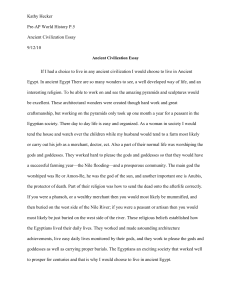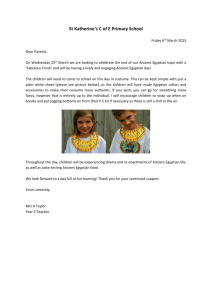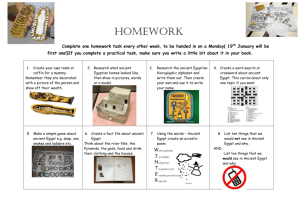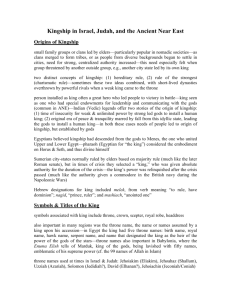File
advertisement
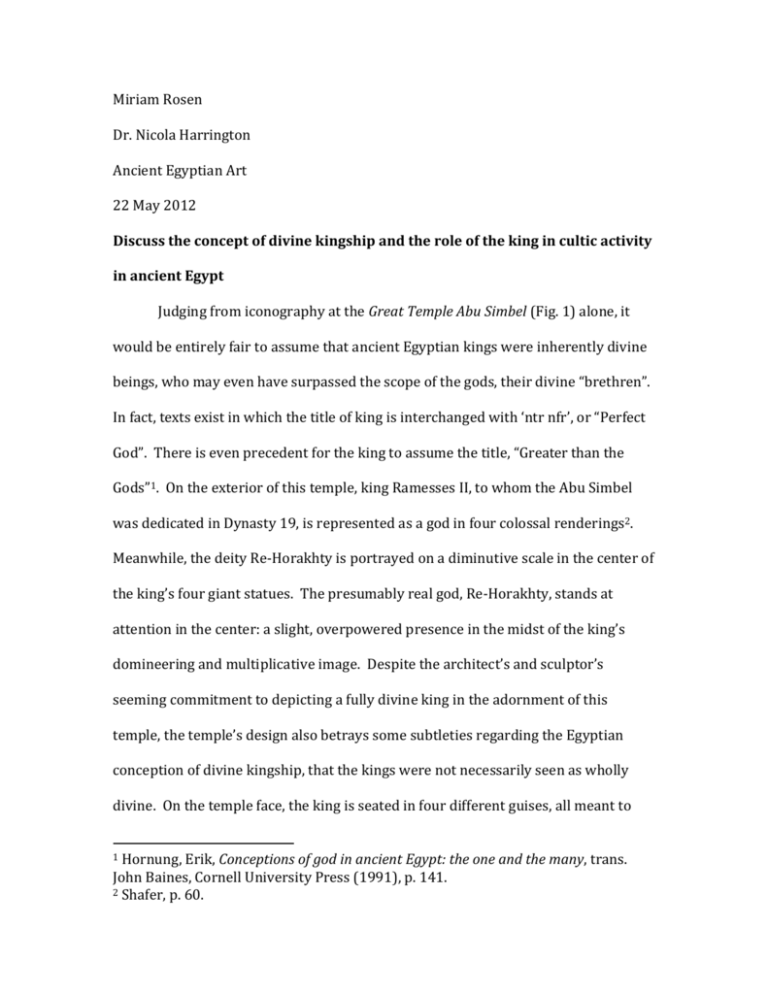
Miriam Rosen Dr. Nicola Harrington Ancient Egyptian Art 22 May 2012 Discuss the concept of divine kingship and the role of the king in cultic activity in ancient Egypt Judging from iconography at the Great Temple Abu Simbel (Fig. 1) alone, it would be entirely fair to assume that ancient Egyptian kings were inherently divine beings, who may even have surpassed the scope of the gods, their divine “brethren”. In fact, texts exist in which the title of king is interchanged with ‘ntr nfr’, or “Perfect God”. There is even precedent for the king to assume the title, “Greater than the Gods”1. On the exterior of this temple, king Ramesses II, to whom the Abu Simbel was dedicated in Dynasty 19, is represented as a god in four colossal renderings2. Meanwhile, the deity Re-Horakhty is portrayed on a diminutive scale in the center of the king’s four giant statues. The presumably real god, Re-Horakhty, stands at attention in the center: a slight, overpowered presence in the midst of the king’s domineering and multiplicative image. Despite the architect’s and sculptor’s seeming commitment to depicting a fully divine king in the adornment of this temple, the temple’s design also betrays some subtleties regarding the Egyptian conception of divine kingship, that the kings were not necessarily seen as wholly divine. On the temple face, the king is seated in four different guises, all meant to Hornung, Erik, Conceptions of god in ancient Egypt: the one and the many, trans. John Baines, Cornell University Press (1991), p. 141. 2 Shafer, p. 60. 1 signify him as the referent. Ramessess’ statues all feature the same characteristics; they possess a unique humanity that establishes the king as attentive and open, with large ears and contemplatively pouting lips. The humanity apparent in the king’s person is in direct contrast to the god, who is depicted as a man with the head of a hawk. Not only does the king’s humanity suggest his mortality but it also suggests his inability to limitlessly extend life by incarnating an animal with his being. Furthermore, the sanction for replication of the king’s, or of any individual’s image, in consecutive statues perhaps speaks to a fundamental Egyptian sensibility: a detachment from the strictures of singular personhood. After the Unification of Upper and Lower Egypt, when the public was encouraged to accept a single ruler as a merging of two, assuming the responsibilities of both Upper and Lower Egypt, there seemed to be a philosophical shift toward mutability of the body. This thread of unification is drawn into the Abu Simbel Temple, too, through the double ‘atef’ crown that Ramesses wears. The crown explicitly represents the station of the king, as the unifier of Upper and Lower Egypt, but perhaps implicitly reminds onlookers of the range of identities that one man, or in this case, one king, can possess. Effectively, he can be a mortal man, a mortal king, a divine king, and a deity, and none are mutually exclusive or discordant. Furthermore, the four kings all sit firmly confronting the viewer’s eye, maintaining seated positions of openness and availability. Re-Horakhty, the central god, however, stands in a niche, high above eye level. In fact, the typical viewer probably does not even get the chance to see his image. The insufficient availability of Re-Horakhty mirrors the real intangibility of the gods throughout ancient Egyptian history in general. This sentiment created the need, then, for some interactive divine figure on earth that was tangible, yet still sacred. For this reason, the notion of a divine king, a god on earth, became attractive to the public. The instability of the king’s divinity, symptomatic of his known mortality, however, most likely caused the rise of the ‘cult of the living king’. By treating the king’s spirit with the same cultic practices afforded the gods, the cults effectively instantiate the concept of king, as separate from the individual king, with the influence of the divine. Essentially, the divine king only becomes divine when he becomes king, and only because the icon of kingship is inextricably linked with divinity. The public in ancient Egypt knew the king to be a mortal human, providing them with an uncomfortable awareness of their divine king’s non-divine tendencies; yet this somehow did not compromise the divinity of the king’s role. There are countless examples throughout ancient Egyptian history that point toward the mortality of the king. For example, each year, the king was required to observe jubilees of ‘revivification’ in order to ensure fertility of the land, which would have been centered on celebration of the fertility gods who would then generate said fertility of the land. Also, kings needed to be buried in tombs to ensure afterlife, while this was of course not the case for gods3. In fact, in Tutankhamun’s tomb, the South Wall (Fig. 2) depicts a scene in which the king is welcomed to the Afterlife by the god Anubis, the goddess Hathor, and the goddess Isis, from whom all beginnings arise. Traditionally, this scene is said to be the one in which Tutankhamun becomes immortal, and thus indicates that he was mortal and subservient to the gods Silverman, David P., “Divinity and deities in ancient Egypt,” in B. E. Shafer (ed.), Religion in ancient Egypt. Ithaca and London, Cornell University Press, (1991), p. 58. 3 throughout his life. Furthermore, royal subjects were not ignorant of the king’s origins. Often, the king was among the sons born to the previous pharaoh and his main wife. When such an heir did not exist, the king might have been plucked from among the sons of the pharaoh and a minor wife, or a distant relative, or even a close confidante of the pharaoh4. Moreover, these rises to power weren’t always universally supported. Sometimes royal conspiracies arose; essentially, political conniving was not alien to ancient Egyptian culture. The foul play that sometimes ensued did much to remind people of the flesh-and-blood nature of their kings. In fact, the public was so aware of the physical, animate properties of their royalty, that they even sketched sexual encounters on the walls of mortuary temples. Queen Hatshepsut’s mortuary temple at Deir el-Bahri has one particularly graphic scene (Fig. 3) that is often interpreted to be an animation of Hatshepsut, herself, with Senenmut, her courtier5. Ironically, the narrative of the queen’s divine birth is depicted on the opposite wall. Indeed, this point may not be ironic at all. Texts, documents, and other artworks throughout these periods all bear signs of the divinity of kings. The king’s dual nature of humanity and divinity, then, could only have existed within the ideological framework of an Egypt post-unification, which itself set the tone for the multiplicity of the individual. The king, through various texts and depictions, was established as the product of multiple parentages. He “had been begotten by Amon-Re upon the queen mother. As regards his divine potency, he was Horus, the son of Hathor. As the legitimate successor to the throne… he was the 4 5 Silverman, p. 60. Silverman, p. 62. son of Osiris and Isis, the grandson of Geb, the earth”6. Effectively, the tradition held that the king’s background was variable based on variable functions. The same was essentially true of his kingship and divinity. Most often, the kings were conflated with the sun god, but comparable pairings exist, where the king is labelled as Horus, Mont, Khnum, Sakhmet, and others7. The diorite-gneiss statue of Khefren (Fig. 4) follows these associations, and also elucidates the idea of a coexistence of divinity and humanity. On the statue, an inscription reads, “Horus in the palace”. Meanwhile, the king’s head is sheltered beneath the wings of a falcon, the animal form of Horus. The juxtaposition of the falcon with Khefren highlights the fact that both are vessels of the god Horus, and that he inhabits both. However, they both maintain their own identity in human and animal form, separate from Horus, the abstract god. Availability and accessibility then becomes a salient issue in the communion of the public with the divinity. Because the “gods belonged to an invisible world inhabited only by the divine”8, the kings stepped in as grounded gods, and they were essentially treated as such by the public. In Ancient Egyptian Religion, Stephen Quirke discusses the cult statues of deities in different localities around Egypt. In each temple, “the deity took tangible form in its cult image, not in full identity but, according to the Egyptian texts, as a vessel in which the deity could rest and through Frankfort, Henri, Kingship and the gods: a study of ancient Near Eastern religion as the integration of society and nature, Chicago, University of Chicago Press (1948), p. 299. 7 Hornung, p. 141 8 Silverman, p. 63. 6 which it could be given service and worship”9. He goes on to explain that the practice of “denominating an object as a means of access to a deity created a paradox, that the image was present on earth and could be touched, but that it held divinity and ought not to be touched except under the most rigorous controls.” Because a king acted as a similar form of vessel through which the divine gods touched down onto earth, there was a mystique around the kings as extensions of the gods. Perhaps in an attempt to reconcile the increasingly muddled territory of mortal –vs- god inhabited by the king, cults devoted to living kings began to emerge, creating and treating statues of kings similar to those used for the local deity temples. Effectively, in order to fully serve the divine king, cults extracted the godliness from the corporeality of the king, eliminating the bodily element and focusing all attentions on the spirit of divinity. This spirit was injected through the “Opening of the Mouth” ceremony, much like those ceremonies for gods’ statues, in which “”life” was imparted”10 to the inanimate image. This statue then became a living being, which needed sustenance as any living being would. Every day, the image of the deity was presented with clean clothes, and morning and evening meals. In the morning, it needed to be taken from its closed shrine, given fresh clothes and ornaments, brought to an incense-burning and chanting ritual, and offered food and drink. In the evening, the reverse service was performed, and the image was returned behind the bolted doors of its shrine for the nighttime11. Only the priest could attend to these processes, and the statues were mainly inaccessible Quirke, Stephen, Ancient Egyptian religion. London, British Museum Press (1992), p. 75. 10 Frankfort, p. 305 11 Quirke, p. 75. 9 to the public. In effect, then, the cult of the living king negotiated the muddled status of the divine king by isolating the source of his divinity to his kingship, imbuing an object with that spirit of divinity, and treating the object, which housed the unadulterated divinity of the king, as if it were a deity, once again inaccessible to the public. WORKS CITED Frankfort, Henri, Kingship and the gods: a study of ancient Near Eastern religion as the integration of society and nature, Chicago, University of Chicago Press (1948). Hornung, Erik, Conceptions of god in ancient Egypt: the one and the many, trans. John Baines, Cornell University Press (1991): 135–142. Lorton, David, “Towards a constitutional approach to ancient Egyptian kingship” [review of Untersuchungen zur Göttlichkeit des regierenden Königs: Ritus und Sadralkönigtum in Altägypten nach Zeugnissen der Frühzeit und des Alten Reiches, Münchner Ägyptologische Studien 32 by Winfried Barta], Journal of the American Oriental Society 99, 3 (1979): 460–65. O’Connor, D. and Silverman, D. (eds.), Ancient Egyptian kingship. Leiden, Brill (1995). Quirke, Stephen, Ancient Egyptian religion. London, British Museum Press (1992): 70–103. Silverman, David P., “Divinity and deities in ancient Egypt,” in B. E. Shafer (ed.), Religion in ancient Egypt. Ithaca and London, Cornell University Press, (1991): 58–87. Figure 1. Great Temple Abu Simbel Figure 2. South Wall of Tutankhamun’s Tomb (Left side: recovered portion depicting Isis) // Figure 3. Graffito from Queen Hatshepsut’s Tomb in Deir-al Bahri Figure 4. Khefren Diorite-gneiss statue





